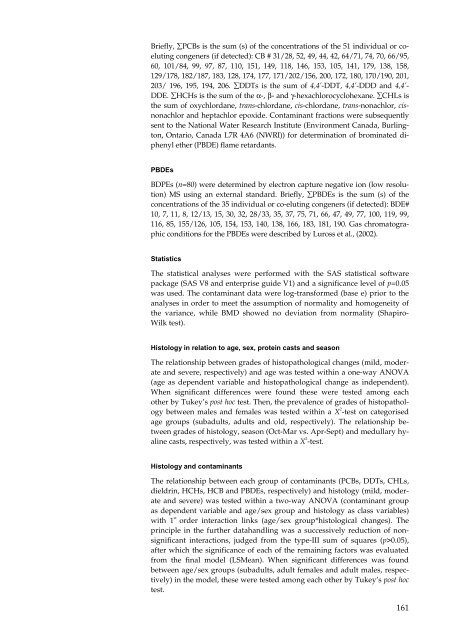Organohalogen concentrations and a gross and histologic ...
Organohalogen concentrations and a gross and histologic ...
Organohalogen concentrations and a gross and histologic ...
Create successful ePaper yourself
Turn your PDF publications into a flip-book with our unique Google optimized e-Paper software.
Briefly, ∑PCBs is the sum (s) of the <strong>concentrations</strong> of the 51 individual or coeluting<br />
congeners (if detected): CB # 31/28, 52, 49, 44, 42, 64/71, 74, 70, 66/95,<br />
60, 101/84, 99, 97, 87, 110, 151, 149, 118, 146, 153, 105, 141, 179, 138, 158,<br />
129/178, 182/187, 183, 128, 174, 177, 171/202/156, 200, 172, 180, 170/190, 201,<br />
203/ 196, 195, 194, 206. ∑DDTs is the sum of 4,4’-DDT, 4,4’-DDD <strong>and</strong> 4,4’-<br />
DDE. ∑HCHs is the sum of the α-, β- <strong>and</strong> γ-hexachlorocyclohexane. ∑CHLs is<br />
the sum of oxychlordane, trans-chlordane, cis-chlordane, trans-nonachlor, cisnonachlor<br />
<strong>and</strong> heptachlor epoxide. Contaminant fractions were subsequently<br />
sent to the National Water Research Institute (Environment Canada, Burlington,<br />
Ontario, Canada L7R 4A6 (NWRI)) for determination of brominated diphenyl<br />
ether (PBDE) flame retardants.<br />
PBDEs<br />
BDPEs (n=80) were determined by electron capture negative ion (low resolution)<br />
MS using an external st<strong>and</strong>ard. Briefly, ∑PBDEs is the sum (s) of the<br />
<strong>concentrations</strong> of the 35 individual or co-eluting congeners (if detected): BDE#<br />
10, 7, 11, 8, 12/13, 15, 30, 32, 28/33, 35, 37, 75, 71, 66, 47, 49, 77, 100, 119, 99,<br />
116, 85, 155/126, 105, 154, 153, 140, 138, 166, 183, 181, 190. Gas chromatographic<br />
conditions for the PBDEs were described by Luross et al., (2002).<br />
Statistics<br />
The statistical analyses were performed with the SAS statistical software<br />
package (SAS V8 <strong>and</strong> enterprise guide V1) <strong>and</strong> a significance level of p=0.05<br />
was used. The contaminant data were log-transformed (base e) prior to the<br />
analyses in order to meet the assumption of normality <strong>and</strong> homogeneity of<br />
the variance, while BMD showed no deviation from normality (Shapiro-<br />
Wilk test).<br />
Histology in relation to age, sex, protein casts <strong>and</strong> season<br />
The relationship between grades of histopathological changes (mild, moderate<br />
<strong>and</strong> severe, respectively) <strong>and</strong> age was tested within a one-way ANOVA<br />
(age as dependent variable <strong>and</strong> histopathological change as independent).<br />
When significant differences were found these were tested among each<br />
other by Tukey’s post hoc test. Then, the prevalence of grades of histopathology<br />
between males <strong>and</strong> females was tested within a X 2<br />
-test on categorised<br />
age groups (subadults, adults <strong>and</strong> old, respectively). The relationship between<br />
grades of histology, season (Oct-Mar vs. Apr-Sept) <strong>and</strong> medullary hyaline<br />
casts, respectively, was tested within a X 2<br />
-test.<br />
Histology <strong>and</strong> contaminants<br />
The relationship between each group of contaminants (PCBs, DDTs, CHLs,<br />
dieldrin, HCHs, HCB <strong>and</strong> PBDEs, respectively) <strong>and</strong> histology (mild, moderate<br />
<strong>and</strong> severe) was tested within a two-way ANOVA (contaminant group<br />
as dependent variable <strong>and</strong> age/sex group <strong>and</strong> histology as class variables)<br />
with 1 st order interaction links (age/sex group*<strong>histologic</strong>al changes). The<br />
principle in the further datah<strong>and</strong>ling was a successively reduction of nonsignificant<br />
interactions, judged from the type-III sum of squares (p>0.05),<br />
after which the significance of each of the remaining factors was evaluated<br />
from the final model (LSMean). When significant differences was found<br />
between age/sex groups (subadults, adult females <strong>and</strong> adult males, respectively)<br />
in the model, these were tested among each other by Tukey’s post hoc<br />
test.<br />
161

















